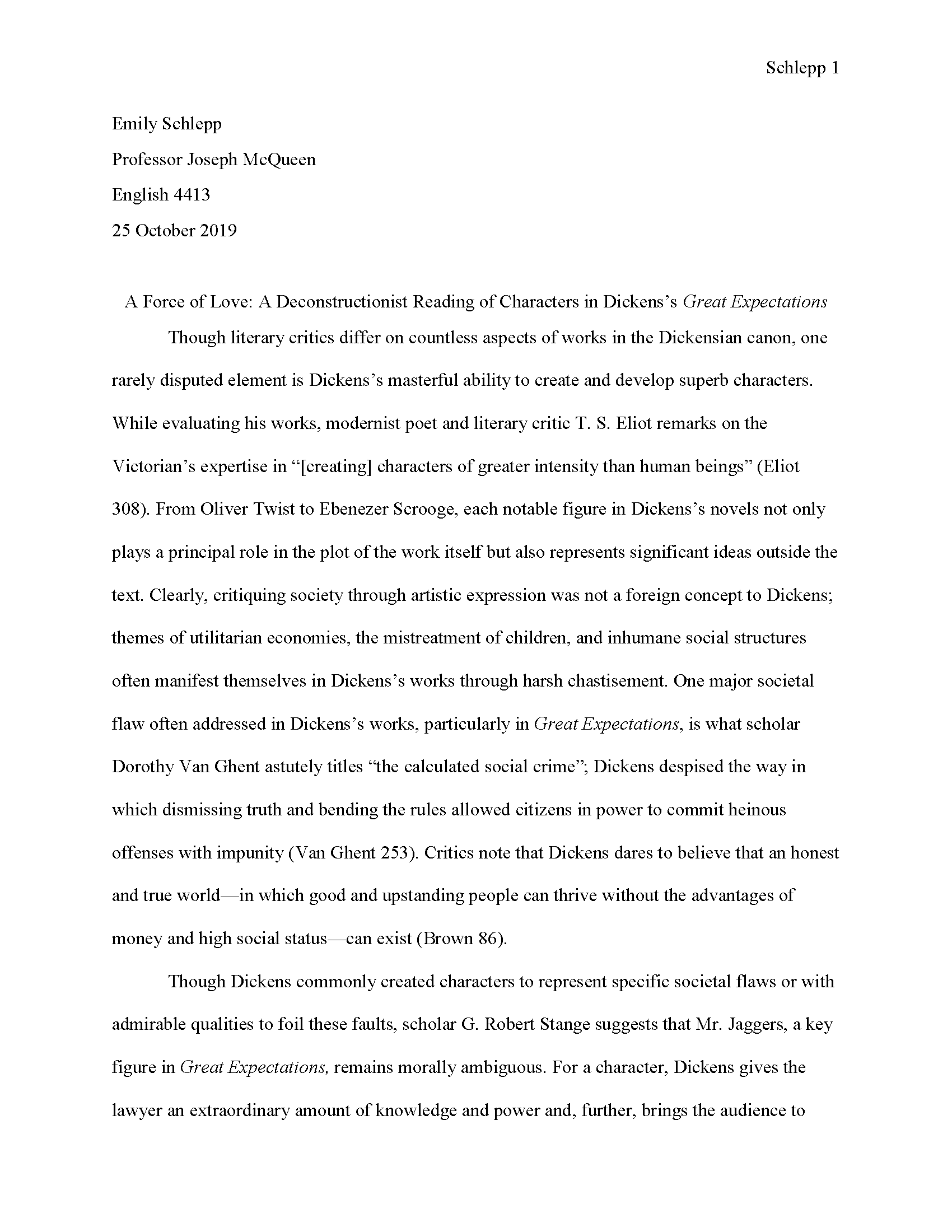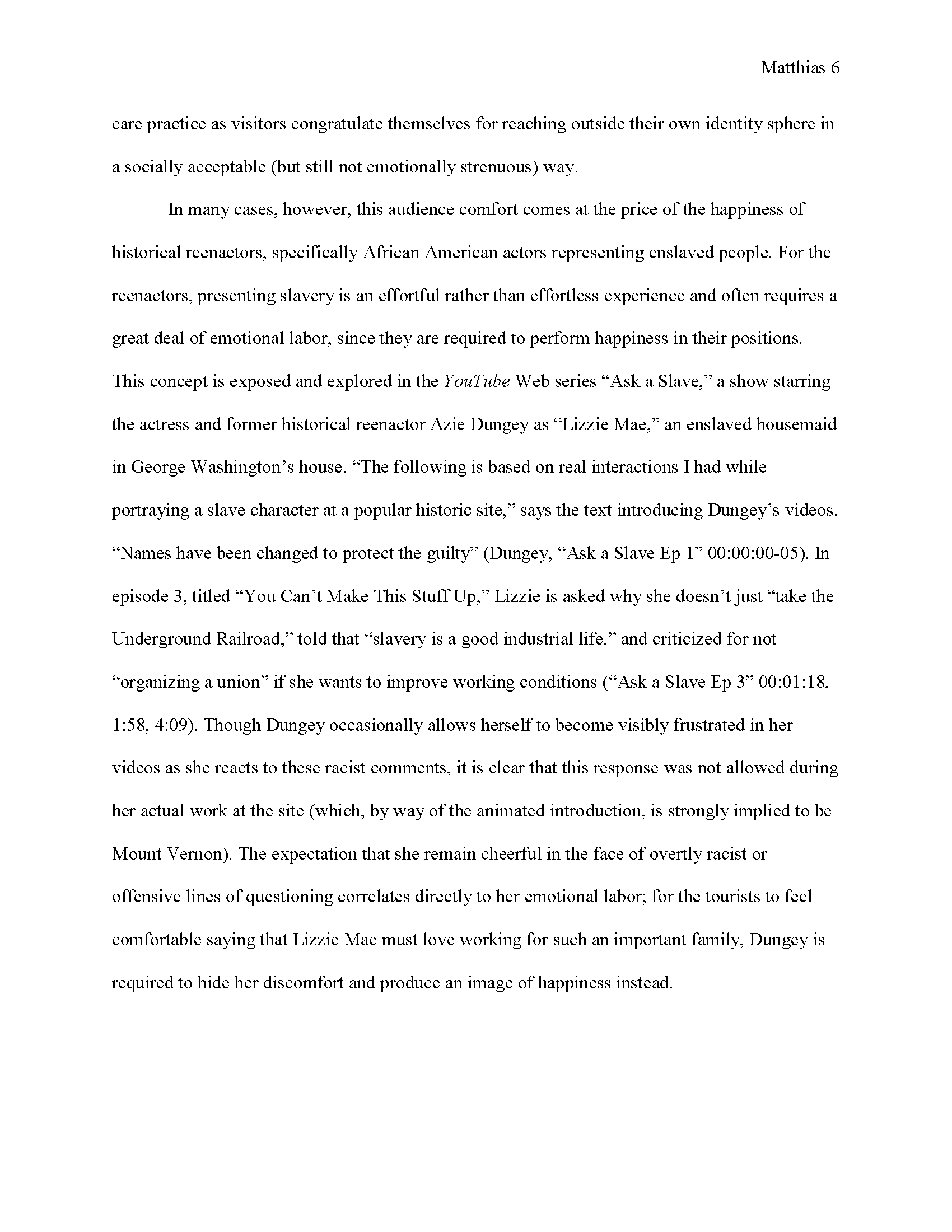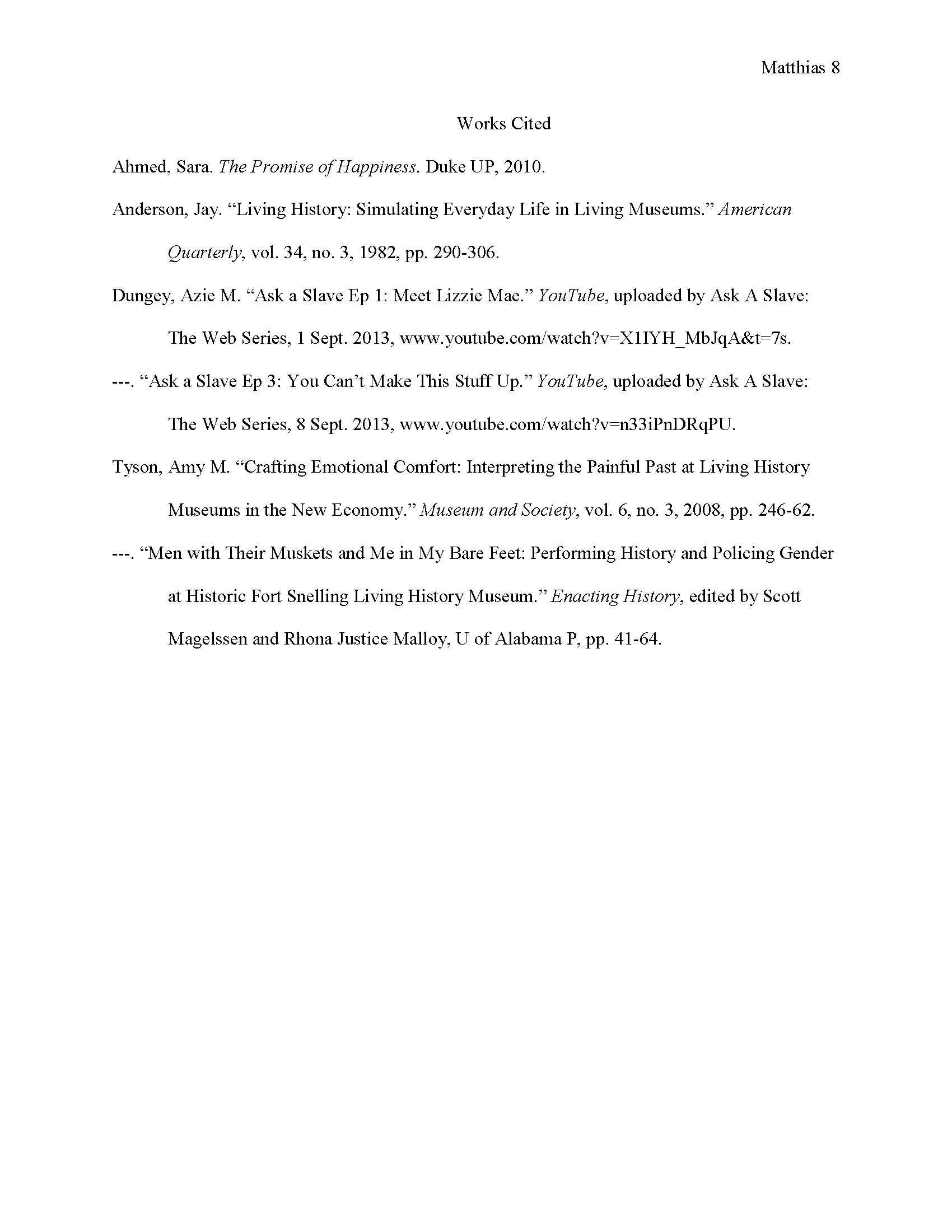Chapter 47: MLA Parenthetical or In-Text Citations
About In-Text Citations
In-text citations are used throughout your paper to credit your sources of information. In MLA style, the in-text citation in the body of the essay links to the Works Cited page at the end. This way, the reader will know which item in the Works Cited is the source of the information.
The in-text citation is offset with parentheses, clearly calling attention to itself for the reader. The reference to the author or title is like a signal to the reader that information was incorporated from a separate source. It also provides the reader with information to then turn to the Works Cited section of the essay (at the end) where they can find the complete reference.
If you follow MLA style and indicate your source both in your essay and in the Works Cited section, you will prevent the possibility of plagiarism. If you follow MLA guidelines, pay attention to detail, and clearly indicate your sources, then this approach to formatting and citation offers a proven way to demonstrate your respect for other authors and artists.
The ninth edition of the MLA Style Guide states that your in-text, or parenthetical, citations should do the following:
-
Clearly indicate the specific sources also referenced in the works cited
-
Specifically identify the location of the information that you used
-
Carefully create a clear and concise citation, always confirming its accuracy
-
Check out the video below for more discussion of your in-text citations.
MLA Style: In-Text Citations by Scribbr on Youtube
Examples of In-Text Citations
Typically, MLA in-text citations include the author’s name and the page number. See examples of in-text citations in this sample paper:


Use of In-Text Citations
When writing, make sure you inform the reader when you are using information from a source, whether that be direct quotations or paraphrasing information. And, it should be equally clear when you are expressing your own ideas.
If someone else wrote it, said it, drew it, demonstrated it, or otherwise expressed it, you need to cite it.
How much of my paper should be cited?
Your paper should include no more than 25% direct quotes (and many instructors will think this is too high a percentage). If you have too many direct quotes, paraphrase information from your source instead of using direct quotes. Remember: you are writing this paper. Your words should be the most prominent aspect of your paper.
What Type of Material to Cite
This material must always be cited:
- A direct quote
- A statistic
- An idea that is not your own
- Someone else’s opinion
- Concrete facts, not considered “common knowledge”
- Knowledge not considered “common”
You do not need to cite common, widespread knowledge. If you find the same information listed in five or more sources, you can assume this is common knowledge. For example, the fact that mollusks live in both saltwater and freshwater is common knowledge.
But you would cite this information:
New research on mollusks shows that “the snail’s gene sequence has remained almost unchanged throughout its evolution” (“Genomic Secrets of Scaly-foot Snail”).
Direct Quotes and Paraphrase
There are two types of citations: direct quotes and paraphrase. When you cite an author word-for-word, you will enclose that direct quotation in quotation marks:
According to the EPA, “the total generation of municipal solid waste (MSW) in 2017 was 267.8 million tons (U.S. short tons, unless specified) or 4.51 pounds per person per day” (“Facts and Figures about Materials, Waste and Recycling”).
If you paraphrase—put in your own words—someone else’s work, do not use quotation marks, but still cite your source:
While that Starbucks coffee cup and McDonald’s bag do not seem like a great deal of trash, each person averages 4.51 pounds of waste per day (“Facts and Figures about Materials, Waste and Recycling”).
Plagiarism
In your paper, when you quote directly from a source in their words, or when you paraphrase someone else’s idea, you need to tell the reader what that source is so the author gets credit for their words and ideas. The in-text citation gives the reader the source of the material.
If you do not credit the work of other writers –taking credit for their work as if you wrote it—you are committing plagiarism. If you do not enclose direct quotes in quotation marks or cite the source, you are committing plagiarism.
In the professional world, plagiarism results in loss of credibility and often compensation, including future opportunities. In a classroom setting, plagiarism results in a range of sanctions, from loss of a grade to expulsion from a school or university. CNM outlines the consequences for academic dishonesty in its Code of Conduct. In both professional and academic settings, the penalties are severe.
If you use someone else’s work, cite it. Give credit where credit is due.
Formatting In-Text Citations
Where to Place In-Text Citation
You must cite your sources as you use them. In the same way that a table or figure should be located right next to the sentence that discusses it (see the examples in the Format section), in-text citations are required.
Place the in-text citation at the end of the sentence containing the information cited. Do not simply put the in-text citation at the end of a paragraph. Show the reader which sentences include source material. If all the sentences in your paragraph comes from one source, that’s your cue to start analyzing and interpreting your sources more. You can learn more about analyzing and interpreting sources in Part 4 of this book.
Elements of the In-Text Citation
The purpose of the in-text citation is to show the reader the source of the information the writer is citing. So, the information in the in-text citation needs to lead directly to the source listed in the Works Cited page. When you have completed your Works Cited page, check to make sure the in-text citation matches the first words of the Works Cited source entry.
Usually, the Works Cited source entry will begin with an author’s last name. If there is no author, then the name of the article is the first information listed.
Sources with No Page Numbers
If you are using a website or other electronic source that does not have page numbers, use only the author’s name or title of the source in the in-text citation.
Here are examples:
- If the source has page numbers: (Pauling 113).
- If the source does not have page numbers: (Pauling).
- If the source has page numbers: (“Bilingual Minds” 113).
- If the source does not have page numbers: (“Bilingual Minds”).
In the examples below, page numbers are listed. If your source does not have page numbers, follow the directions for the in-text citation, but omit the page number.
Sources with Authors
If your source has an author listed, then scroll through this section to see which one applies.
Source by a Single Author
In-text citations should include simply the author’s last name (with no first or middle initial). If you’re citing a direct quote, you also need to include the page number. For example:
Social representations theory posits that reified scientific knowledge that exists at the boundaries of a given society will be interpreted in meaningful and often simplified forms by the majority (Pauling 113).
Social representations theory “proposes a new hypothesis …” (Pauling 113).
If you choose, you can integrate the author’s name into the sentence itself—this is known as a “signal phrase”—and provide just the page number in parentheses:
Pauling posits that “scientific knowledge…” (113).
Source by Two Authors
Authors should be presented in the order in which they are listed on the published article. If you include the authors’ names in the parenthetical, use the word “and” between the two names. For example:
Social representations theory posits that reified scientific knowledge that exists at the boundaries of a given society will be interpreted in meaningful and often simplified forms by the majority (Pauling and Liu 113).
Using a signal phrase:
Pauling and Liu (113) posit that …
Source by Three or More Authors
For an article with three or more authors, to save space and to make your paper easier to read, you should use only the first author’s last name followed by “et al.”, and then the page number, if applicable (“et al.” is short for “et alia,” which means “and other people” in Latin—much like “etc.” is short for “et cetera,” which means “and other things” in Latin.):
(Pauling et al. 113)
Using a signal phrase
Pauling et al. posit …” that the chicken came before the egg” (113).
Multiple Publications by Different Authors
If you need to cite multiple publications by different authors in the same sentence, you should list the multiple sources in alphabetical order by author and use a semicolon to separate them.
… majority (Alford 24; Pauling 113; Sirkis 96).
Multiple Publications by the Same Author
If an author has multiple publications that you want to cite in the same sentence, include the author’s name in a signal phrase and the titles of the referenced sources instead in the parenthetical citation.
Achenbach’s recent research (“Bibliography of Published Studies” 17) demonstrates a radical shift in thinking from his stance of a decade ago (“School-Age Assessments” 39).
Complete the following questions to solidify your understanding of these citation guidelines.
Sources with Titles but No Known Author
Source by No Known Author with page number
For an article with no known author, use the source title in place of the author’s name, formatted as it would be (i.e., italicized or enclosed in quotation marks) in your Works Cited section.You may abbreviate the title, using only the first few words:
(“Bilingual Minds, Bilingual Bodies” 4)
Using a signal phrase:
The article “Bilingual Minds, Bilingual Bodies” (4) claims …
Non-Print Internet Sources
Most sources from the library databases will have authors listed. However, some internet sources do not have authors listed. Include in the text the first item that appears in the Work Cited entry that corresponds to the citation (e.g. author name, article name, website name, film name). A couple of things to remember:
- Do not use paragraph numbers or page numbers based on your Web browser’s view
- Do not include URLs in the in-text citation
If you are referring to the website as a whole, only provide partial URLs such as when the name of the site includes, for example, a domain name, like CNN.com or Forbes.com, as opposed to writing out the whole URL and including a hyperlink like http://www.cnn.com or http://www.forbes.com.
When giving advice about saving for retirement, Forbes.com suggests starting a Roth Savings account (“Four Ways to Boost your Retirement”).
Time-based Media Sources: Videos, Podcasts, etc.
When citing a movie, video, podcast, or any other media that has a run-time, include the range of hours, minutes and seconds you plan to reference. For example:
See an example of here:


Citing Indirect Sources
If another source is cited within your source, it is called an “indirect source. When citing this, use “qtd. in” to indicate the source you actually consulted. For example:
However, Ben Bonham argues that banjos are superior instruments “due to their long history in American folk music” (qtd. in Hulett 259).
However, it is a best practice to attempt to find the original source, rather than cite an indirect source.
The first part of this chapter is adapted from English for Business Success, 2012, used according to Creative Commons 3.0 cc-by-nc-sa
Sections of this chapter are written by Anne Key and published by Central New Mexico Community College, 2020, used according to Creative Commons CC BY NC SA 4.0

